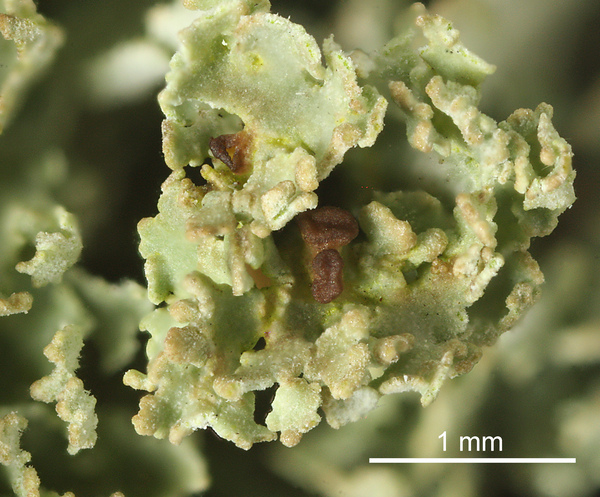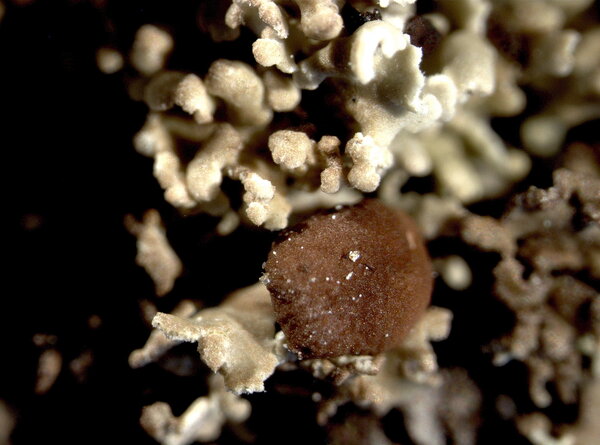Cladonia caespiticia (Pers.) Flörke
Clad. Comm.: 8, 1828. Basionym: Baeomyces caespiticius Pers. - Ann. Bot. (Usteri), 7: 155, 1793 (“1794”).
Synonyms: Cladonia agariciformis (Wulfen) Arnold
Distribution: N - VG, Frl (Burgaz & al. 2020), Ven, TAA, Lomb (Rivellini & Valcuvia 1996, Zocchi & al. 1997, Stofer 2006, Abramini & al. 2008, Furlanetto 2010, Gheza 2018, 2019, Gheza & al. 2020, 2022), Piem (Isocrono & al. 2004, Gheza 2018, 2020), VA (Borlandelli & al. 1996, Piervittori & Isocrono 1997, 1999, Valcuvia & al. 2000b), Emil (Nimis & al. 1996, Fariselli & al. 2020), Lig (Putortì & al. 1999b, Giordani & Incerti 2008, Gheza & al. 2020). C - Tosc (Loppi & al. 1997b, 1999a, Putortì & al. 1999, Loppi & Putortì 2001, Brunialti & al. 2012b), Laz (Stofer 2006), Sar (HAL-7276). S - Camp, Pugl, Cal (Stofer 2006), Si.
Description: Primary thallus squamulose, the squamules persistent, 1-10 mm long, 2-5 mm wide, strongly divided and irregularly incised, ascending, mostly forming dense, low cushions, pale grey-green to brownish green above, white and very finely arachnoid beneath. Podetia very small, 1-5 mm tall, 0.4-1.5 mm thick, partly ecorticate, rarely with a few squamules, cupless, almost translucent when wet (no photobiont!). Apothecia peltate, sessile on squamules or terminal on the podetia, single or clustered, pale to dark brown, more or less translucent when wet, convex. Asci 8-spored, clavate, thickened at apex, with a K/I+ blue tholus and a K/I+ strongly blue outer gelatinous sheath, Cladonia-type. Ascospores 1-celled, hyaline, ellipsoid. Pycnidia brown, semi-immersed on the upper surface of the squamules, ovoid to conical, constricted at base, with a colourless jelly. Conidia hyaline, curved. Photobiont chlorococcoid. Spot tests: K-, C-, KC-, P+ rapidly red, UV-. Chemistry: fumarprotocetraric acid.Note: a cool-temperate to southern boreal-montane, circumpolar lichen found on mineral, generally sandy-clay soil, occasionally on rotting wood and at the base of ancient trunks in sheltered situations. The records from Southern Italy (Nimis 1993: 225) need reconfirmation.
Growth form: Fruticose
Substrata: soil, terricolous mosses, and plant debris
Photobiont: green algae other than Trentepohlia
Reproductive strategy: mainly sexual
Most common in areas with a humid-warm climate (e.g. most of Tyrrenian Italy)
Commonnes-rarity: (info)
Alpine belt: absent
Subalpine belt: extremely rare
Oromediterranean belt: extremely rare
Montane belt: very rare
Submediterranean belt: extremely rare
Padanian area: absent
Humid submediterranean belt: extremely rare
Humid mediterranean belt: absent
Dry mediterranean belt: absent

Predictive model
Herbarium samples


Felix Schumm – CC BY-SA 4.0
[17993], Germany, Baden-Württemberg, Kreis Göppingen, nordöstlich von Baiereck im Brillergehren, rasig auf Baumrinde, 48.75909° N, 9.52401° E, 450 m, TK 7224. Leg. Schumm 11.05.2012, det. Schumm 2012.


Felix Schumm – CC BY-SA 4.0
[17993], Germany, Baden-Württemberg, Kreis Göppingen, nordöstlich von Baiereck im Brillergehren, rasig auf Baumrinde, 48.75909° N, 9.52401° E, 450 m, TK 7224. Leg. Schumm 11.05.2012, det. Schumm 2012.


Felix Schumm – CC BY-SA 4.0
[17993], Germany, Baden-Württemberg, Kreis Göppingen, nordöstlich von Baiereck im Brillergehren, rasig auf Baumrinde, 48.75909° N, 9.52401° E, 450 m, TK 7224. Leg. Schumm 11.05.2012, det. Schumm 2012.


Felix Schumm – CC BY-SA 4.0
[17993], Germany, Baden-Württemberg, Kreis Göppingen, nordöstlich von Baiereck im Brillergehren, rasig auf Baumrinde, 48.75909° N, 9.52401° E, 450 m, TK 7224. Leg. Schumm 11.05.2012, det. Schumm 2012.
Growth form: Fruticose
Substrata: soil, terricolous mosses, and plant debris
Photobiont: green algae other than Trentepohlia
Reproductive strategy: mainly sexual
Most common in areas with a humid-warm climate (e.g. most of Tyrrenian Italy)
Commonnes-rarity: (info)
Alpine belt: absent
Subalpine belt: extremely rare
Oromediterranean belt: extremely rare
Montane belt: very rare
Submediterranean belt: extremely rare
Padanian area: absent
Humid submediterranean belt: extremely rare
Humid mediterranean belt: absent
Dry mediterranean belt: absent

Predictive model
| Herbarium samples |


Felix Schumm – CC BY-SA 4.0
[17993], Germany, Baden-Württemberg, Kreis Göppingen, nordöstlich von Baiereck im Brillergehren, rasig auf Baumrinde, 48.75909° N, 9.52401° E, 450 m, TK 7224. Leg. Schumm 11.05.2012, det. Schumm 2012.


Felix Schumm – CC BY-SA 4.0
[17993], Germany, Baden-Württemberg, Kreis Göppingen, nordöstlich von Baiereck im Brillergehren, rasig auf Baumrinde, 48.75909° N, 9.52401° E, 450 m, TK 7224. Leg. Schumm 11.05.2012, det. Schumm 2012.


Felix Schumm – CC BY-SA 4.0
[17993], Germany, Baden-Württemberg, Kreis Göppingen, nordöstlich von Baiereck im Brillergehren, rasig auf Baumrinde, 48.75909° N, 9.52401° E, 450 m, TK 7224. Leg. Schumm 11.05.2012, det. Schumm 2012.


 Index Fungorum
Index Fungorum
 GBIF
GBIF













